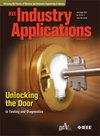Model-Free Predictive Current Control of PMSM Based on Sliding Mode Disturbance Observer
IF 4.5
2区 工程技术
Q2 ENGINEERING, ELECTRICAL & ELECTRONIC
引用次数: 0
Abstract
Model predictive current control (MPCC) based on sliding mode disturbance observer (SMDO) effectively addresses the issues arising from parameter mismatches and unmodeled nonlinear elements in Permanent magnet synchronous motor (PMSM). However, conventional sliding mode faces a trade-off between reaching speed and chattering, and their closed-loop transfer functions are often challenging to derive. To overcome these limitations, this paper proposes a model-free predictive current control method based on an adaptive sliding mode disturbance observer (ASMDO-MFPCC). By exploiting a novel decoupled PMSM ultra-local model and a novel sliding mode control law, a discrete-time observer is designed to enhance convergence speed and suppress chattering. The stability of the observer is analyzed, and its parameter ranges are theoretically determined. Moreover, by linearizing the control law near the designed sliding surface, a complex vector linear model is established for the entire system, allowing closed-loop transfer function analysis to confirm that deadbeat performance can be preserved under accurate parameter settings. To further improve the system’s robustness, a simple yet effective inductance identification algorithm is proposed for real-time calibration of the predictive control system. This algorithm operates independently of the observer design. Experimental results validate the effectiveness of the proposed current control scheme.基于滑模干扰观测器的永磁同步电机无模型预测电流控制
基于滑模扰动观测器(SMDO)的模型预测电流控制(MPCC)有效地解决了永磁同步电机(PMSM)中参数不匹配和非线性元件未建模的问题。然而,传统的滑模面临着达到速度和抖振之间的权衡,其闭环传递函数往往难以推导。为了克服这些局限性,本文提出了一种基于自适应滑模干扰观测器(ASMDO-MFPCC)的无模型预测电流控制方法。利用新的解耦PMSM超局部模型和滑模控制律,设计了离散时间观测器,提高了收敛速度,抑制了抖振。分析了观测器的稳定性,从理论上确定了观测器的参数范围。此外,通过对设计滑动面附近的控制律进行线性化,建立了整个系统的复向量线性模型,通过闭环传递函数分析,确认在精确的参数设置下仍能保持系统的无差拍性能。为了进一步提高系统的鲁棒性,提出了一种简单有效的电感识别算法,用于预测控制系统的实时标定。该算法独立于观测器设计而运行。实验结果验证了所提电流控制方案的有效性。
本文章由计算机程序翻译,如有差异,请以英文原文为准。
求助全文
约1分钟内获得全文
求助全文
来源期刊

IEEE Transactions on Industry Applications
工程技术-工程:电子与电气
CiteScore
9.90
自引率
9.10%
发文量
747
审稿时长
3.3 months
期刊介绍:
The scope of the IEEE Transactions on Industry Applications includes all scope items of the IEEE Industry Applications Society, that is, the advancement of the theory and practice of electrical and electronic engineering in the development, design, manufacture, and application of electrical systems, apparatus, devices, and controls to the processes and equipment of industry and commerce; the promotion of safe, reliable, and economic installations; industry leadership in energy conservation and environmental, health, and safety issues; the creation of voluntary engineering standards and recommended practices; and the professional development of its membership.
 求助内容:
求助内容: 应助结果提醒方式:
应助结果提醒方式:


